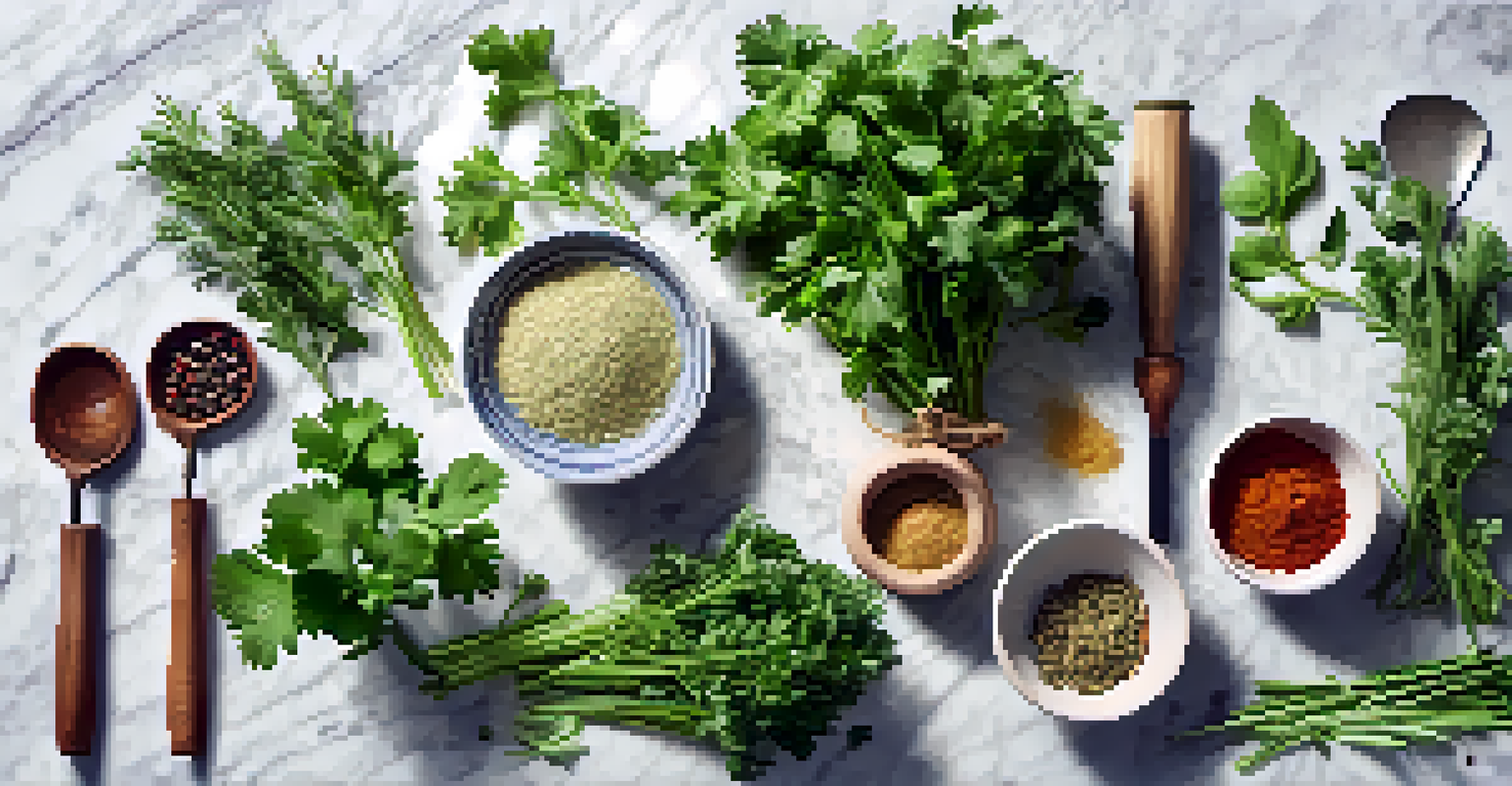Cilantro vs. Parsley: Flavor Profiles and Culinary Uses

Understanding Cilantro: Flavor and Aroma
Cilantro, also known as coriander leaves, boasts a vibrant, citrusy flavor that can evoke a love-it-or-hate-it reaction. This herb's aroma is often described as fresh and slightly peppery, making it a striking addition to various dishes. Its unique taste is attributed to the presence of certain aldehydes, which some people perceive as soapy due to genetic factors.
Herbs are the spice of life; they bring flavor and joy to our meals.
When used in cooking, cilantro shines brightest in Mexican, Indian, and Thai cuisines, adding a refreshing kick to salsas, curries, and salads. It’s often used as a garnish, sprinkled just before serving to maintain its bright flavor and color. Whether you love it or not, cilantro definitely leaves an impression on your palate.
In addition to its culinary uses, cilantro is also packed with health benefits, including antioxidants and vitamins that support digestion and heart health. So, not only does it enhance your meals, but it can also contribute to your well-being. Embracing cilantro can enrich your culinary experience and introduce a burst of flavor to your favorite dishes.
Exploring Parsley: The Versatile Herb
Parsley is often seen as the mild-mannered sibling of cilantro, offering a fresh, slightly peppery flavor that enhances dishes without overpowering them. Its subtle taste makes it a versatile ingredient, suitable for both cooking and garnishing. With its bright green leaves and flat or curly varieties, parsley adds visual appeal to any plate.

Commonly found in Mediterranean and Middle Eastern cuisine, parsley is a staple in tabbouleh, chimichurri, and various sauces. Its ability to complement a wide range of flavors makes it a go-to herb for chefs and home cooks alike. Plus, it can be used in salads, soups, and even smoothies, demonstrating its adaptability.
Cilantro's Bold Flavor Shines
Cilantro adds a vibrant, citrusy kick to dishes, making it a favorite in spicy cuisines.
Beyond its culinary prowess, parsley is rich in vitamins A, C, and K, making it a nutritious addition to your meals. It also contains antioxidants that may help combat inflammation. By incorporating parsley into your dishes, you're not just enhancing flavor but also boosting your health.
Cilantro vs. Parsley: Flavor Showdown
When it comes to flavor, cilantro and parsley couldn't be more different. Cilantro's bold, zesty notes contrast sharply with parsley's mild, earthy taste. This distinction makes each herb suitable for different culinary applications and preferences, with cilantro often used in spicier dishes and parsley in more subtle ones.
Cooking is like love. It should be entered into with abandon or not at all.
For instance, in a fresh salsa, cilantro's lively flavor can elevate the dish, while parsley would enhance a creamy pasta dish without overshadowing other ingredients. This flavor showdown highlights the importance of choosing the right herb for your culinary creations, based on the desired taste profile.
Ultimately, the choice between cilantro and parsley often comes down to personal preference. Some people love cilantro's strong flavor, while others prefer the gentle touch of parsley. Understanding these differences can help you make informed decisions in the kitchen, ensuring your dishes are perfectly seasoned.
Culinary Uses of Cilantro: Beyond Garnish
Cilantro is more than just a garnish; it's a star ingredient in many dishes. Its bold flavor makes it ideal for salsas, guacamole, and marinades, where it can shine without competing with other flavors. Additionally, cilantro is often blended into sauces and dressings, creating a punchy flavor that can elevate any meal.
In Asian cuisine, cilantro is frequently found in stir-fries and soups, adding a fresh note to rich and savory flavors. Its versatility extends to beverages as well, with cilantro appearing in some cocktails and smoothies for an unexpected twist. The herb's ability to infuse dishes with brightness makes it a favorite among many chefs.
Parsley's Versatile Appeal
Parsley enhances meals with its mild flavor and can be used in a variety of dishes, from salads to sauces.
Using cilantro in your cooking is all about balance. Its strong flavor can enhance a dish, but too much can overwhelm it. A little goes a long way, so start with a small amount and adjust according to your taste, ensuring your dishes are flavorful without being overpowered.
Culinary Uses of Parsley: A Flavorful Companion
Parsley is often used as a seasoning or garnish, but its culinary potential goes far beyond that. It can be a key ingredient in sauces like chimichurri or pesto, providing a fresh flavor that complements other ingredients beautifully. Parsley can also be added to soups, stews, and casseroles, enhancing the flavor profile without overpowering the dish.
In salads, parsley adds a crunchy texture and refreshing taste. It’s a key component of tabbouleh, a Middle Eastern salad that highlights parsley's versatility. This herb can also be blended into dips or spreads, such as hummus, to introduce a subtle green flavor that balances richness.
The beauty of parsley lies in its ability to enhance a dish while remaining understated. It can be used liberally without the risk of overwhelming other flavors, making it a reliable choice for various culinary applications. Whether fresh or dried, parsley is a must-have herb for any kitchen.
Nutritional Benefits: Cilantro and Parsley
Both cilantro and parsley offer impressive nutritional benefits, making them excellent additions to a balanced diet. Cilantro is rich in vitamins A, C, and K, as well as minerals like potassium and manganese, all of which support overall health. Its antioxidant properties can also help combat oxidative stress in the body.
On the other hand, parsley is a nutritional powerhouse, packed with vitamins C, K, and several B vitamins, as well as iron and fiber. This herb can aid in digestion and promote heart health, making it more than just a pretty garnish on your plate. Adding parsley to your meals can provide a significant nutrient boost.
Nutritional Benefits of Both Herbs
Both cilantro and parsley are rich in vitamins and antioxidants, supporting overall health while adding flavor to meals.
Incorporating both herbs into your diet can unlock a range of health benefits. They can be seamlessly added to a variety of dishes, ensuring you're enjoying their flavors while also nourishing your body. So next time you cook, consider how cilantro and parsley can enhance not just your meals but your well-being as well.
Final Thoughts: Choosing the Right Herb for Your Dish
When it comes to choosing between cilantro and parsley, it's essential to consider the specific flavors and dishes you're preparing. Cilantro’s bold profile is perfect for vibrant, spicy dishes, while parsley is ideal for those seeking a more subtle enhancement. Understanding your palate and the ingredients at play will guide your choice.
Experimenting with both herbs can open up new culinary possibilities. You might find that cilantro adds the perfect zing to a dish, while parsley serves as the perfect complement in another. By trying different combinations, you can discover what works best for your cooking style.

Ultimately, both cilantro and parsley deserve a place in your kitchen. They each bring unique flavors and benefits to the table, enriching your meals and expanding your culinary repertoire. So, whether you’re team cilantro or team parsley, embrace the diversity these herbs offer in your cooking adventures.